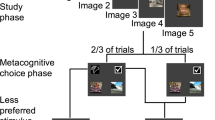Abstract
The images of human working memory are coded by systems of cyclically repeating cerebral processes. The dominant frequency of the cyclical oscillations in an alpha rhythm focus, approximately 10 Hz, and the duration of the relative refractoriness after the impulse discharge of the neuron, approximately 0.01 sec, determine the diversity of the character of the bioelectrical activity of the human brain, and thereby determine the capacity and speed of working memory. The higher the frequency and the briefer the refractory state, the greater the capacity and the speed of memory. Methods for the assessment of both parameters on the basis of the individual characteristics of the human electroencephalogram in the state of its relative rest are indicated. Formulas are presented for the calculation of the capacity of memory and the duration of the operations of collation of images perceived and those stored in memory.
Similar content being viewed by others
References
N. P. Bekhtereva,The Healthy and Ill Human Brain [in Russian], Nauka, Leningrad (1980).
N. N. Danilova,Functional States: Mechanism and Diagnostics [in Russian], Izd-vo MGU, Moscow (1985).
E. R. Dzhon [John?], “A neurophysiological model of goal-directed behavior,” in:The Neurophysiological Mechanisms of Behavior [Russian translation], Nauka, Moscow (1982).
Yu. M. Zabrodin and A. N. Lebedev,Psychophysiology and Psychophysics [in Russian], Nauka, Moscow (1977).
M. Klyains and M. Kon, “The identification of visual stimuli on the basis of electrical reactions of the brain,” in:Computer Technology in Investigations of Disturbances of Human Mental Activity [in Russian], Meditsina, Moscow (1971).
A. N. Lebedev, “A hypothesis on neuronal memory codes,” in:Current Problems of Psychophysiology and Neuropsychology [in Russian], Izd-vo In-ta psikhologii RAN, Moscow (1991), pp. 9–19.
A. N. Lebedev, “The neurophysiological bases of perception and memory,”Psikhol. Zhurn.,13, No. 2, 30–41 (1992).
A. N. Lebedev and L. Ya. Nilova,Mikhail Nikolaevich Livanov. Materials for a Biobibliography [in Russian], Nauka, Moscow (1983).
M. N. Livanov,The Spatial Organization of Cerebral Processes [in Russian], Nauka, Moscow (1972).
M. N. Livanov,Selected Works. The Spatial-Temporal Organization of Potentials and the Systemic Activity of the Brain, P. V. Simonov, et al. (eds) [in Russian], Nauka, Moscow (1989).
M. N. Livanov, “Inhibition in the neuronal systems of the cerebral cortex,” in:Brain Reflexes [in Russian], Nauka, Moscow (1965).
G. [?J.] Miller, “The magical number seven, plus or minus two,” in:Engineering Psychology [Russian translation], Radio, Moscow (1964).
I. Yu. Myshkin, A. N. Lebedev, and V. V. Maiorov,Psychophysiological Methods of the Study of States [in Russian], Izd-vo YarGU, Yaroslavl' (1988).
G. I. Shul'gina,The Bioelectrical Activity of the Brain and the Conditioned Reflex [in Russian], Nauka, Moscow (1978).
E. Basar,EEG-Brain Dynamics: Relation Between EEG and Brain Evoked Potentials. Elsevier-North Holland, Amsterdam (1980).
H. Berger, “Das Elektroenkephalogramm des Menschen,”Nova Acta Leopoldina,6, 137–309 (1938).
W. E. Hick, “On the rate of gain of information,”Quart. J. Exp. Psychol., 4, 11–27 (1952).
A. N. Lebedev, “Note on derivation of equations for speed and capacity of perception. The skeleton of a psychological theory,” in:Psychophysical Judgments and the Process of Perception, H.-G. Geissler and P. Petzold (eds.), Wissenschaften, Berlin (1980), pp. 282–285.
Author information
Authors and Affiliations
Additional information
Translated from Zhurnal Vysshei Nervnoi Deyatel'nosti imeni I. P. Pavlova, Vol. 43, No. 2, pp. 277–285, March–April, 1993.
Rights and permissions
About this article
Cite this article
Lebedev, A.N. The neurophysiological parameters of human memory. Neurosci Behav Physiol 24, 254–259 (1994). https://doi.org/10.1007/BF02362031
Received:
Accepted:
Issue Date:
DOI: https://doi.org/10.1007/BF02362031




